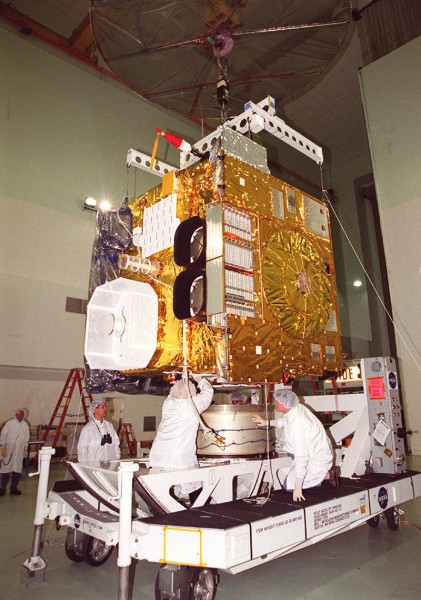Farewell, GOES-12…
Farewell to a valuable set of eyes 22,300 miles above us!

This is what GOES-12 looked like as crews with Space Systems/Loral prepared for its July 23, 2001 launch into space…
GOES-12, the weather satellite launched in July, 2001 by the National Oceanic and Atmospheric Administration, is being retired, its operators have announced.
Intended to operate for about five years, GOES-12 turned out to be a warrior, instead, wildly surpassing expectations.
Going into service April 1, 2003, the satellite sat above the Equator, monitoring developing weather systems across the eastern United States and part of the Atlantic ocean for about ten years.
Under its watch, the satellite—which became known as GOES-East—saw a lot, including Hurricane Katrina’s devastating strike along the Gulf coast in 2005, the Christmas blizzard that pounded the central U.S. in 2009, and countless severe weather episodes.
There’s no telling how many lives have been saved with the help of this marvel of technology.
GOES-12 even did a bit of traveling, itself. In May, 2010, the satellite was shifted south of the Equator and provided coverage over South America, where it monitored wildfires, drought and volcanic ash clouds.
In the place of GOES-12 is GOES-13, serving as the current GOES-East, which works in partnership with GOES-15. Together, these two satellites provide coverage from the Atlantic ocean west across the entire continental U.S., into the Pacific ocean.
If you’re curious about the break in numbers (what happened to GOES-14?), there’s an explanation.
GOES-14 is up there, too, but is not in service. Instead, it remains available as a stand-by/back-up, should a problem develop with either GOES-13 or GOES-15.
GOES, by the way, stands for Geostationary Operational Environmental Satellite.
What’s next for GOES-12?
NOAA will use up the satellite’s remaining fuel to boost it to a higher orbit (so it will be less of a collision threat to operational spacecraft), its batteries will be disabled, and transmitters will be turned off (to reduce any potentially interfering signals).
Just how much did GOES-12 see during its service time? NOAA has taken ten years worth of GOES-12 observations and packed them into 3 minutes:
Category: Met 101/Weather History

















